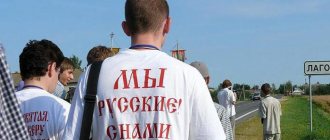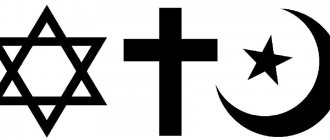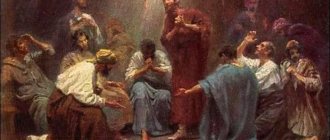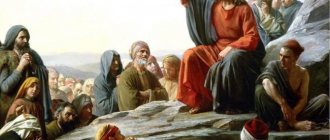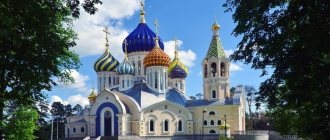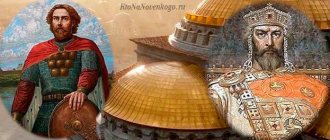Christianity has many faces. In the modern world it is represented by three generally recognized directions - Orthodoxy, Catholicism and Protestantism, as well as numerous movements that do not belong to any of the above. There are serious differences between these branches of the same religion. The Orthodox consider Catholics and Protestants to be heterodox groups of people, that is, those who glorify God in a different way. However, they do not view them as completely devoid of grace. But Orthodox Christians do not recognize sectarian organizations that position themselves as Christian but are only indirectly related to Christianity.
Differences between Orthodoxy and Christianity
What is the difference between these two concepts? Everything is very simple. All Orthodox are Christians, but not all Christians are Orthodox. Followers, united by the confession of this world religion, are divided by belonging to a separate direction, one of which is Orthodoxy. To understand how Orthodoxy differs from Christianity, you need to turn to the history of the emergence of world religion.
True believers will certainly be interested in an article about the purpose of archangels in Orthodoxy.
The meaning of the word Christianity
Christianity
is one of the three so-called. world religions (along with Buddhism and Islam). It has three main directions: Orthodoxy, Catholicism, Protestantism. It is based on faith in Jesus Christ as the God-man, the Savior, the incarnation of the 2nd person of the triune Godhead (see Trinity). The introduction of believers to Divine grace occurs through participation in the sacraments. The source of the doctrine of Christianity is Holy Tradition, the main thing in it is the Holy Scripture (Bible); as well as the “Creed”, decisions of ecumenical and some local councils, individual works of the church fathers. Christianity arose in the 1st century. n. e. among the Jews of Palestine, it immediately spread to other peoples of the Mediterranean. In the 4th century. became the state religion of the Roman Empire. By the 13th century. all of Europe was Christianized. In Rus', Christianity spread under the influence of Byzantium from the 10th century. As a result of the schism (division of churches), Christianity in 1054 split into Orthodoxy and Catholicism. From Catholicism during the Reformation in the 16th century. Protestantism emerged. The total number of Christians exceeds 1 billion people. - [from Greek. Christ is the Anointed One, the Messiah; according to the New Testament text Acts of the Apostles 11:26, formed on the basis of the Greek language with the use of the Latin suffix, the noun christianoi - adherents (or followers) of Christ, Christians, first came into use to designate supporters of the new faith in the Syrian-Hellenistic city of Antioch in the 1st century .], one of the world religions (along with Buddhism and Islam), one of the so-called. “Abrahamic” (or “Abrahamic”) religions, successor to biblical monotheism (along with Judaism and Islam). Cultural context of early Christianity Christianity arose in the 1st century. in Palestine in the context of the messianic movements of Judaism, with which, however, it soon found itself in a state of conflict (the exclusion of Christians from synagogue life after the 70s, culminating in the drawing up of formal curses against Christians as “heretics”). Initially it spread among the Jews of Palestine and the Mediterranean diaspora, but already from the first decades it received more and more followers among other peoples (“pagans”). Until the end of the Roman Empire, the spread of Christianity occurred mainly within its borders, with a special role played by the eastern outskirts - Asia Minor, the land of those 7 churches that in the Revelation of John the Theologian (chap. 2 - 3) symbolize the fate of the Universal Church; Egypt is the cradle of Christian monasticism, and, thanks to the urban environment of Alexandria, also of Christian learning and philosophy; It is also necessary to note the importance of such “buffer” territories between the Roman Empire and Iran (Parthian, later Sasanian Empire), such as Armenia (which officially adopted Christianity somewhat earlier than the famous Edict of Milan 313 of the Roman Emperor Constantine, which is discussed below). The linguistic situation of early Christianity was complex. The sermon of Jesus sounded in the spoken language of the then Palestine - Aramaic, which belonged to the Semitic group and very close to Syriac (there is information about the Aramaic original of the Gospel of Matthew; Semitologists are inclined to admit that the oldest Syriac version of the Gospels is only partly a translation from Greek, and partly retains memories about the original form of the sayings of Jesus (cf. Black M. An Aramaic approach to the Gospels and Acts. 3 ed. Oxford, 1969).However, the language of interethnic communication in the Mediterranean space was a different language - Greek (the so-called Koine); In this language, the texts of the most sacred book of Christianity - the New Testament are written. Therefore, the history of Christian culture (in contrast to the culture of Islam) begins on the border of languages and civilizations; characteristically, the ancient tradition according to which the Apostle Peter preached, having Mark (the future evangelist) as a translator. In Rome, Christian literature has long been created in Greek, which characterizes the cosmopolitan environment of the early Christian community, which was dominated by immigrants from the East (Christian Latin, which was to become the sacred language of the Catholic branch of Christianity in a symbolic connection with papal Rome, takes its first steps not so much in Rome, how many in North Africa).Creed. The doctrine of God. Christianity (as later Islam) inherited the idea of a single God, matured in the Old Testament tradition, who has His cause in Himself, in relation to Whom all persons, beings and objects are creations created from nothing, and all-goodness, all-vision and omnipotence - unique attributes. The personal understanding of the Absolute, characteristic of the Bible, receives a new development in Christianity, expressed in the two central dogmas of Christianity, which constitute its most important difference from Judaism and Islam - the Trinity and the Incarnation. According to the dogma of the Trinity, the internal life of the Divine is a personal relationship between three “Hypostases”, or Persons: the Father (the beginningless Origin), the Son, or “Word” - the Logos (the semantic and formative Principle) and the Holy Spirit (the “life-giving” Principle). The Son is born from the Father, the Holy Spirit “proceeds” from the Father (according to Orthodox teaching) or from the Father and the Son (the so-called filioque, a feature of Catholic doctrine, also adopted by Protestantism and which has become the common property of Western confessions); but both “birth” and “procession” take place not in time, but in eternity; all three Persons were always (“eternal”) and equal in dignity (“equally honest”). Christian “Trinitarian” teaching (from Latin Trinitas - Trinity), developed in the era of the so-called. Fathers of the Church (“Patristics,” which flourished in the 4th - 5th centuries) and clearly rejected only in some ultra-Protestant denominations, demands “not to confuse the Persons and not to separate the Essence”; in the accentuated demarcation of the levels of the essential and the hypostatic is the specificity of the Christian Trinity in comparison with the triads of other religions and mythologies (for example, the Trimurti of Hinduism). This is not unity, non-differentiation or duality; The persons of the Christian Trinity are considered accessible to mutual communication precisely because of the unconditional “hypostatic” independence and have this independence due to mutual openness in love. The doctrine of the God-man (Christology) The image of the semi-divine Mediator between the divine and human planes of existence is known to the most diverse mythologies and religions. However, Jesus Christ is not a demigod for Christological dogma, that is, some intermediate being lower than God and higher than man. It is for this reason that the incarnation of God is understood in Christianity as one-time and unique, not allowing any reincarnation in the spirit of pagan, eastern or gnostic mysticism: “Christ died once for our sins, and after resurrection from the dead he dies no more!” - this is the thesis defended by St. Augustine against the doctrine of eternal recurrence (On the City of God XII, 14, 11). Jesus Christ is the “Only Begotten,” the only Son of the One God, not to be included in any series similar to, say, the fundamental plurality of bodhisattvas. (Therefore, attempts to accept Christ as one of many, to include Him in a number of prophets, teachers of mankind, “great enlightened ones” are unacceptable for Christianity - from the trends of late antique syncretism sympathetic to the new faith, through Manichaeism and Islam, which gave Christ the status of the predecessor of their prophets, right up to theosophy and other “esoteric” doctrines of modern and modern times). This increases the severity of the paradox inherent in the doctrine of the incarnation of God: the absolute infinity of God turns out to be embodied not in an open series of partial incarnations, but in a single “incarnation”, so that the omnipresence of God is contained within one human body (“in Him dwells all the fullness of the Godhead bodily,” Colossians 2:9), and His eternity is within a unique historical moment (the identity of which is so important to Christianity that it is specifically mentioned in the Nicene-Constantinopolitan Creed : Christ was crucified “under Pontius Pilate,” that is, during the time of such and such a governor - the mystical event is not just empirically, but doctrinally correlated with a date, with a world-historical, and therefore worldly, chronology, cf. also Luke 3:1). Christianity rejected as heresies all doctrines that tried to smooth out these paradoxes: Arianism, which denied “co-originlessness” and the ontological equality of the Son to the Father, Nestorianism, which separated the divine nature of the Logos and the human nature of Jesus, Monophysitism (see Monophysites), on the contrary, which spoke of the absorption of the human nature of Jesus by the divine nature of the Logos. The doubly paradoxical formula of the 4th Ecumenical (Chalcedon) Council (451) expressed the relationship of the divine and human natures, preserving their fullness and identity in the God-manhood of Christ - “truly God” and “truly man” - with four negations: “ unmerged, untransformed, inseparable, inseparable.” This formula outlines a universal paradigm for Christianity of the relationship between the divine and the human. Ancient philosophy developed the concept of non-passion, non-affectability of the divine principle; Christian theological tradition assimilates this concept (and defends it against the heresy of the so-called Patripassians), but conceives precisely this non-suffering present in the suffering of Christ on the cross and in His death and burial (according to the Orthodox liturgical text, sharpening the paradox, by crucifixion and Before the Resurrection, the personal hypostasis of Christ is simultaneously localized in the most diverse ontological and mystical planes of existence - “in the grave carnally, in hell with the soul like God in paradise with the thief and on the throne... with the Father...”).AnthropologyThe human situation in Christianity is considered acutely contradictory. In the original, “primordial” state and in God’s final plan for man, mystical dignity belongs not only to the human spirit (as in ancient idealism, as well as in Gnosticism and Manichaeism), but also to the body. Christian eschatology teaches not just the immortality of the soul, but the resurrection of the transfigured flesh - in the words of the Apostle Paul, “the spiritual body” (First Epistle to the Corinthians 15:44); in the situation of disputes of the late antique era, this brought upon Christianity the ridicule of pagan Platonists and paradoxical-sounding accusations of excessive love for the physical. The ascetic program, formulated by the same Paul in the words “I pacify and enslave my body” (ibid., 9: 27), ultimately has as its goal not the separation of the spirit from the body, but the restoration of the spirituality of the body, violated by sin. The Fall, i.e. The first act of disobedience to God, committed by the first people, destroyed man's godlikeness - this is the weight of the so-called. original sin. Christianity has created a sophisticated culture of judging one’s own guilt (in this regard, such literary phenomena of the era of the Church Fathers as Augustine’s “Confession” and the confessional lyrics of Gregory the Theologian are characteristic); The most revered Christian saints considered themselves great sinners, and from the Christian point of view they were right. Christ defeated the ontological power of sin, “redeemed” people, as if redeeming them from slavery from Satan with His suffering. Christianity highly values the cleansing power of suffering - not as an end in itself (the ultimate destination of man is eternal bliss), but as the most powerful weapon in the war against evil peace. Therefore, from the point of view of Christianity, the most desirable state of a person in this life is not the calm painlessness of a Stoic sage or a Buddhist “enlightened one,” but the tension of struggle with oneself and suffering for everyone; Only by “accepting his cross” can a person, according to Christian understanding, defeat evil in himself and around him. “Humility” is viewed as an ascetic exercise in which a person “cuts off” his self-will and through this, paradoxically, becomes free. The descent of God to man is at the same time a requirement for man’s ascent to God; a person must not only be brought to obedience to God and fulfill the commandments, as in Judaism and Islam, but transformed and elevated to the ontological level of divine existence (the so-called “deification”, especially clearly thematized in Orthodox mysticism). “We are now children of God; but it has not yet been revealed what we will be. We only know that (...) we will be like Him, because we will see Him as He is” (First Epistle of John 3:2). If a person does not fulfill (at least having gone through severe afterlife trials, called “ordeals” in the Orthodox tradition, and “purgatory” in the Catholic tradition) his mystically high purpose and fails to respond to the sacrificial death of Christ, then he will be rejected for all eternity; There is ultimately no middle ground between unearthly glory and destruction. The Doctrine of the Sacraments Associated with the concept of God’s incomprehensibly high plan for man is the concept of “sacrament”, alien to other religions, as a completely special action that goes beyond the limits of ritual, rite; if rituals symbolically correlate human life with divine existence and thereby guarantee the stability of balance in the world and man, then the sacraments (Greek mysterion, Latin sacramentum), according to the traditional Christian understanding, actually introduce the divine presence into human life and serve as a guarantee of future “deification” , the breakthrough of eschatological time. The most important of the sacraments, recognized by all faiths, are baptism (initiation, introducing into Christian life and stopping, according to the teachings of Christianity, the effect of the inertia of original sin) and the Eucharist, or communion (eating bread and wine, invisibly transubstantiated according to church faith into the Body and Blood of Christ for the sake of the essential union of the believer with Christ, so that Christ “lives in him”). Orthodoxy and Catholicism recognize 5 more sacraments, the sacramental status of which is denied by Protestantism: anointing, which aims to impart to the believer the mystical gifts of the Holy Spirit and, as it were, crowning Baptism; repentance (confession to the priest and absolution); ordination or ordination (ordination to the clergy, which gives not only the authority to teach and “pastorally” lead the faithful, but also - in contrast to the purely legal status of a rabbi in Judaism or a mullah in Islam - primarily the authority to administer the sacraments); marriage, understood as participation in the mystical marriage of Christ and the Church (Ephesians 5:22-32); unction (accompanied by prayers, anointing the body of a seriously ill person with oil as a last resort to return to life and at the same time a farewell to death). The concept of a sacrament, always bodily concrete, and the ethics of asceticism are subordinated in Christianity to the idea of the high purpose of all human nature, including the bodily principle, which must be prepared for eschatological enlightenment by both asceticism and the action of the sacraments. The ideal of ascetic-sacramental existence is the Virgin Mary, who, precisely thanks to her virginity, realizes in her physical existence as the Mother of God the sacramental presence of the Divine in the human world. (It is characteristic that in Protestantism, where the experience of the sacrament weakens, the ascetic institution of monasticism, as well as the veneration of the Virgin Mary, naturally disappears). Christianity and Monarchy The administration of the Roman Caesars for a long time considered Christianity as a complete negation of the official norm, accusing Christians of “hatred of the human race”; refusal to participate in pagan rituals, especially in the religious and political cult of the emperor, brought bloody persecution on Christians. The impact of this fact on the specific emotional atmosphere of Christianity was very profound: those who were subjected to the death penalty (martyrs) or imprisonment and torture (confessors) for their adherence to Christianity were the first in the history of Christianity to be revered as saints, the ideal of the martyr (correlated with the image of the crucified Jesus Christ) became the central paradigm of Christian ethics, which views the whole world as being under the unrighteous power of the “prince of this world” (Satan, see Gospel of John 14:30; 16:11, etc.), and proper behavior as peaceful resistance to this power and, therefore, acceptance suffering. At the same time, the universal-civilizing character of the Roman Empire was consonant with the universal spirit of Christianity, addressing all people; early Christian authors of the 2nd-3rd centuries. (who are usually called apologists, since in conditions of persecution and attacks they came out with an apology for their faith) called in their writings, often formally addressed to the holders of power, for reconciliation between the Church and the empire. Having become at the beginning of the 4th century. thanks to the initiative of Emperor Constantine, the officially permitted (and by the end of the same century, the dominant) religion in the Roman Empire, Christianity came under the patronage for a long time, but also under the tutelage of state power (the so-called “Constantinian era”); the borders of the Christian world for some time approximately coincide with the borders of the empire (and Greco-Roman civilization), so that the position of the Roman (later Byzantine) emperor is perceived as the rank of the only supreme secular “primate” of all Christians in the world (on whose initiative, in particular, the Ecumenical Councils met cathedrals of the 4th-7th centuries, recognized not only by Catholics, but also by Orthodox). This paradigm, which represents an analogy to the caliphate in early Islam and was animated by the need for religious wars specifically with Islam, was theoretically significant even at the end of the Western Middle Ages - for example, for Dante Alighieri’s treatise “On the Monarchy” (1310-11). Moreover, it determined the Byzantine ideology of the sacred power and, in part, some traditions of the Orthodox branch of Christianity (cf. in Muscovite Rus' the idea of “Moscow - the third Rome”). In the western half of the Roman Empire, weakness, and then the collapse of statehood led to the rise of the power of the Roman bishop (dad), who also adopted secular functions and argued with the imperial principle on the merits of the same theocratic paradigm. Odnaco and against the backdrop of the sacred of the throne, reality constantly created conflicts Between the Christian conscience and power, reviving the Christian ideals of martyrdom and “confessional”, that is, the moral resistance of power for any era (such key to the Christian tradition of the saints, such as John Chrysostom in the Early University era, Thomas Beket and John Nesumuk (mind. 1393), in the context of medieval Catholicism and Metropolitan Philip in Russian Orthodoxy, are associated precisely with the fulfillment of Christian duty in the face of repressions from the monarchs completely “unique”). (“Schemes”), as a result of which there was a discord of churches and religions (faiths). Already in the 5-7 centuries. In the course of clarification of the doctrine about the combination of the divine and human natural in the personality of Jesus Christ (the so -called Christological disputes), the so -called the Complex of the Roman Empire. “Non-Chalkidonites” (from the name of the 4th Ecumenical Council in Chalcedon)-the Christians of the East, who lived outside the Greek-Latin language zone; The Nestorians who did not recognize the 3rd Ecumenical Council (431), which enjoyed significant influence up to the late Middle Ages in Iran and further east of Central Asia to China [now the community of the so-called. Assyrians ("Aisov"), scattered from the Middle East to the USA, as well as "Christians of St. Thomas "in India]; not recognizing the 4th Ecumenical Council (451) monophysites, which prevailed in the Yakovitsky (Syrian), Gregorian (Armenian), Coptic (Egyptian) and Ethiopian churches; Monofelites, the remainder of which is the Livan Maronite Church of the Livan, secondly united with Catholics. Currently (after scientific analytical work, one of the initiators of which was back in the 19th century, the Russian church scientist V.V. Bolotov), among the Catholic and Orthodox Theological Experts, prevails attitude to the "non-Holcenon" churches as separated not so much by virtue of real Turning differences, how many under the influence of linguistic and cultural misunderstandings and political conflicts. K 1054 was officially proclaimed in the 13th century. The separation of the churches of the Orthodox (with the center in Constantinople) and the Catholic (with the center in Rome) was assigned; Behind him was a conflict of Byzantine ideology of the Holy Power and Latin ideology of the universal papacy, complicated by doctrinal (see above about Filioque) and ritual discrepancies. Attempts of reconciliation (at the 2nd Lyon Cathedral 1274 and especially in the Florence Cathedral 1439) did not have long-term success; Their result was the paradigm of the so -called. “Uniates” or “Catholicism of the Eastern rite” (the combination of the Orthodox ritual and church tradition, including the symbol of faith without Filioque, with the recognition of the Ecumenical Primate Rome), most often led to the psychological exacerbation of the confessional conflict (especially the Brest Union among Ukrainians and Belarusians), as this is often recognized from the Catholic side; However, it is necessary to keep in mind that for about 10 million Christians around the world, Uniagianity has long been inherited and suffered in conflicts. In Russia, the most important Orthodox country after the death of Byzantium in 1453, the tendency in the identification of the church, the kingdom and the people inherent in Byzantine Christianity and to the associated sacralization led in disputes in the 17th century. About the norm of ritual practice to the split, as a result of which the so -called. The Old Believers (the very crushed “sense”). The reformation of the West papacy caused at the end of the Middle Ages the protest both from above, from the secular authorities with whom it entered into the dispute about powers and “below” (Lollards, Husites, etc. P.). On the threshold of the new time, the initiators of the Reformation - Luther, Melanchton, Zwingli, Calvin, etc. - rejected the papacy as reality and ideology; Having destroyed the unity of Western Christianity, the Reformation gave rise to many Protestant faiths, etc. denomination. Protestantism created a culture with its specific features: a special interest in the Bible (including the Old Testament), biblical readings in the family circle; transfer of an emphasis from church sacraments to a preaching, and from personal obedience to spiritual "Primate" and the practice of a regular church confession - to individual responsibility to God; new business ethics, evaluating frugality, order in deeds and self -confidence as a genus of austeria, and success as a sign of God's goodwill; household respectability, equally remote from monastic severity and aristocratic splendor. Such a culture raised people of strong -willed, initiative, internally secluded - the human type, which played an important role in the formation of early capitalism and generally civilization of the new time (cf. the famous concept of “Protestant ethics” by M. Weber). No wonder the Protestant north of Europe (to which the United States later join) generally overtakes the Catholic South in terms of industrialization, not to mention the Orthodox East (and the Old Believers play a special role in the development of traditional capitalism in pre -revolutionary Russia, who have developed the features that represented the cities of tsarist official, representing. The well-known analogy of “Protestant ethics”). Christianity and the new time Odnako in all contrasts and conflicts poured in the 16-17th centuries. In the bloody religious wars, in the future development of confessional branches of Christian culture, some common properties are traced. And the creators of the Protestant education system like the “mentor of Germany” Melanchton, and such extreme advocates of Catholicism as the Jesuits (and the Piarists), subjectively trying to replace each other, objectively develop and impose a new system of school affairs, less repressive than the previous, more oriented for competition between students and aesthetic education; Wed The phenomenon of the Jesuit school theater, which also influenced the Ukrainian-Russian Orthodox culture of the 17th century, in particular, on the poetic work of St. Demetrius of Rostov, which in itself was one of the manifestations of the Orthodox reception of baroque and supervision forms of culture in Kiev (Metropolitan Peter Mogila, and the Kiev-Mogilyansk Academy created by him) and then in Moscow (Slavic-Greco-Latin Academy). It can be noted, for example, the similarity in the methods of public sermon in two consistent currents that arose in the 18th century - in the Catholic congregation of the Redemptorists and such extreme representatives of English Protestantism as methodologists. The second -time trends of the new time are already consistently revealed by the anticlerical wing of the Education: not only was challenged The practice of the Church, but also the teachings of Christianity as such; In contrast, a self -sufficient ideal of earthly progress is advanced to him. The end comes the end of the so -called. “The Union of the Tron and the Altar”, to which the idea of Christian theocracy was reduced (if the early bourgeois revolutions passed under the banner of the Reformation, then during the Great French Revolution the “Dehristianization” campaign, anticipating the “militant athony” of Russian Bolshevism, was already held); The "Konstantinovskaya era" of Christianity as a state religion passed. The familiar concept of “Christian (Orthodox, Catholic, Protestant, etc.) of the nation” is challenged; Throughout the world, Christians live next to unbelievers, and today, at least in view of the mass migration of labor, and next to the dissenters. Today's Christianity has an experience that has no analogues in the past. Already from the 19th century. In Protestantism and especially in Catholicism, there is a tendency to develop on the basis of the Christian doctrine of the social doctrine that meets the tasks of the time (Encyclic of the pope of Leo XIII “Rerum Novarum”, 1891). The liturgical practice of Protestantism, and from the time of the 2nd Vatican Cathedral (1962-65) and Catholicism, seeks considerable to new models of human self-awareness. Similar attempts by Russian post -revolutionary “renovationism” failed both in view of the greater power of Orthodox conservatism, and in view of the fact that the leaders of the “Reductance” compromised themselves as opportunisms at the time of anti -church repressions. The question of the legitimate ratio between the “canon” and the innovation in Christian culture is today primary for all Christian religions. Reforms and shifts cause a sharp reaction of extreme traditionalists insisting the letters of the Holy Scriptures (the so-called fundamentalism is a term that arose as a self-name of the groups of American Protestants, but now used expansion), to the invariability of the rite (the movement of the Catholic "integrist" that rejected 2- The Vatican Cathedral, and in Orthodox Greece - "old calendars"). At the opposite pole - trends (especially in some Protestant denominations) to revisive faithful foundations for the sake of a trouble -free adaptation to the ethics of modern liberalism. Modern Christianity is not a religious self -determination of a homogeneous society, not the heritage of the ancestors, "absorbed with mother's milk", but rather a faith in missionaries and converted; And in this situation, Christianity can help the memory of its first steps - in the space between ethnic groups and cultures. Ecumenism factor in the life of Christianity of the 20th century is an ecumenical movement for the reunification of Christians of various religions. It is due to the situation of Christianity as a faith that re -proposing itself to the non -Christian world; A person, in an act of personal choice by a Christian, is less and less inherited by the skills of the confessional culture of his ancestors, but the mutual scores of faiths that go through centuries become less and less relevant for him. The popular English Christian writer K. S. Lewis wrote a book with the characteristic title “Just Christianity” (Russian per. In the book: Lewis K. S. Love. Nadezhda. Nadezhda. M., 1992); This title successfully expresses the need for the era for the question of the essential core of the Christian teaching, viewed through all the particular characteristics of a historical type. The danger of simplification and impoverishment contained in such a mindset is obvious. But a certain measure of simplification becomes an adequate response to the rigid reality of a radical call, abandoned by Christianity and totalitarianism, and secularist relativism. The variety of theological positions at a depth is replaced by division in two - for or against Christ. Christians of various faiths, who were each other as comrades in fate in the Stalinist and Nazi camps, are the deepest “ecumenical” experience of the century. At the same time, intellectual honesty, by no means forcing the rejection of creed, obliges to see in the real history and life of various faiths, on the one hand, according to the famous formula of Berdyaev, the sad “unworthy of Christians”, contrasting with the “dignity of Christianity”, on the other hand, the affairs Sincere love for God and neighbor (cf. the call of Archbishop John Shakhovsky to see “Sectoralism in Orthodoxy and Orthodoxy in sectarianism”). The ecumenical movement gave expression to these internal shifts. The initiative in this movement belonged to Protestant denominations (Edinburgh Conference 1910); From the Orthodox side, she was supported in 1920 by the message of the Patriarch of Constantinople, addressed to all churches and called them to communicate and cooperation. In 1948, the World Council of Churches (VSC) was created, uniting the most important Protestant denominations and a number of Orthodox local churches, since 1961, the Moscow Patriarchate, as well as observers from the Vatican, take part in its work. In 1965, Pope Paul VI and Patriarch Athenagor announced the abolition of mutual anathemas between the Catholic Rome and the Orthodox Constantinople. Litigation: Christianity. Encyclopedic Dictionary / Ed. S. S. Averintseva et al. M., 1993-95. T. 1-
3. (T.
3. pp. 489-526 - extensive bibliography). Orthodox Theological Encyclopedia / Ed. A. P. Lopukhin and N. N. Glubokovsky. St. Petersburg, 1900-
11. T. 1-
12. Bolotov V.V. Lectures on the history of the ancient Church. St. Petersburg, 1907 —
1918. T. 1-4; The same (reprint). M.,
1994. Spassky A. History of dogmatic movements in the era of the Ecumenical Councils. Sergiev Posad,
1914. T.
1. Kartashev A. V. Ecumenical Councils. M.,
1994. Lossky V. N. Essay on the mystical theology of the Eastern Church. Dogmatic theology. M.,
1991. Meyendorff, prot. I. Introduction to Patristic Theology. Vilnius; M.,
1992. Florovsky, prot. G. Ways of Russian theology. Vilnius,
1991. Florovsky, prot. G. Eastern fathers of the 4th century. Paris, 1931; The same (reprint). M.,
1992. Florovsky, prot. G. Eastern fathers 5-8 centuries. Paris, 1933; The same (reprint). M.,
1992. Kern, archim. Cyprian. Eucharist. Paris, 1947; The same (reprint). M.,
1992. Afanasyev, prot. Nikolai. Joining the Church. M.,
1993. Afanasyev, prot. Nikolai. Church of the Holy Spirit. Riga,
1994. Cassian (Bezobrazov), bishop. Christ and the first Christian generation. 3rd ed. Paris; Moscow,
1996.H. Denzinger - A. Schonmetzer, Enchiridion symbolorum, definitionum et declarationum de rebus fidei et morum, 36 ed. Basileae et Frib.,
1976. Pelikan J. The Christian Tradition. A History of the Development of Doctrine. Chicago, 1971-
78.Bd.1-
3.C. S. Averintsev
Modern explanatory dictionary, TSB
Origins of religions
It is believed that Christianity arose in the 1st century. from the birth of Christ in Palestine, although some sources claim that it became known two centuries earlier. People who preached the faith were waiting for God to come to earth. The doctrine absorbed the foundations of Judaism and philosophical trends of that time; it was greatly influenced by the political situation.
The spread of this religion was greatly facilitated by the sermons of the apostles , especially Paul. Many pagans were converted to the new faith, and this process continued for a long time. Currently, Christianity has the largest number of followers compared to other world religions.
Orthodox Christianity began to stand out only in Rome in the 10th century. AD, and was officially approved in 1054. Although its origins can be dated back to the 1st century. from the birth of Christ. The Orthodox believe that the history of their religion began immediately after the crucifixion and resurrection of Jesus, when the apostles preached a new creed and attracted more and more people to religion.
By the 2nd-3rd centuries. Orthodoxy opposed Gnosticism, which rejected the authenticity of the history of the Old Testament and interpreted the New Testament in a different way that did not correspond to the generally accepted one. Confrontation was also observed in relations with the followers of the presbyter Arius, who formed a new movement - Arianism. According to their ideas, Christ did not have a divine nature and was only a mediator between God and people.
The doctrine of the nascent Orthodoxy was greatly influenced by the Ecumenical Councils , supported by a number of Byzantine emperors. Seven Councils, convened over five centuries, established the basic axioms subsequently accepted in modern Orthodoxy, in particular, they confirmed the divine origin of Jesus, which was disputed in a number of teachings. This strengthened the Orthodox faith and allowed more and more people to join it.
In addition to Orthodoxy and small heretical teachings, which quickly faded in the process of developing stronger trends, Catholicism emerged from Christianity. This was facilitated by the split of the Roman Empire into Western and Eastern. Huge differences in social, political and religious views led to the collapse of a single religion into the Roman Catholic and Orthodox, which at first was called Eastern Catholic. The head of the first church was the Pope, the second - the patriarch. Their mutual separation of each other from the common faith led to a split in Christianity. The process began in 1054 and ended in 1204 with the fall of Constantinople.
Although Christianity was adopted in Rus' back in 988, it was not affected by the schism process. The official division of the church occurred only several decades later, but at the baptism of Russia, Orthodox customs , formed in Byzantium and borrowed from there, were immediately introduced.
Strictly speaking, the term Orthodoxy was practically never found in ancient sources; instead, the word Orthodoxy was used. According to a number of researchers, previously these concepts were given different meanings (orthodoxy meant one of the Christian directions, and Orthodoxy was almost a pagan faith). Subsequently, they began to be given a similar meaning, made synonyms and replaced one with another.
Where does the wind blow from?
The reaction of a representative of Rosenergoatom Concern JSC was caused by suspicion that a release of radionuclides occurred at one of the Russian nuclear power plants.
“It was reported that, according to calculations by the National Institute of Health and the Environment (RIVM) of the Netherlands, these isotopes allegedly came from Russia, and that the cause of the incident could be the depressurization of a fuel element in the reactor of a nuclear power plant,” writes the RIA Novosti agency. .
Indeed, the Dutch institute RIVM analyzed data from Scandinavia and carried out calculations to determine the possible source of the detected radionuclides.
“Radionuclides are artificial, that is, they are created by man. Nuclide composition may indicate damage to a fuel cell in a nuclear power plant. RIVM carried out calculations to clarify the origin of the detected radionuclides. These calculations show that radionuclides come from western Russia. The specific location of the source cannot be identified due to a limited number of measurements,” the institute’s website says, but does not provide more specific information.
]]>
]]>
“Radionuclides come from western Russia,” a message from the Dutch institute RIVM dated June 26, 2021
Later, the RIA Novosti agency tried to refute this report, citing translation problems. But the RIVM Institute confirmed that, in their opinion, radionuclides entered Scandinavia “from western Russia,” which does not mean that their source is located in Russia.
The map, which was attached to her message by the Executive Secretary of the Comprehensive Nuclear-Test-Ban Treaty Organization (CTBTO) Lassina Zerbo, indicates a fairly large area, which includes the southern third of Sweden and the southern half of Finland, as a likely area where the source of emissions may be located. , Estonia, Latvia, as well as the north-west of Russia - from the White Sea to St. Petersburg. Lassina Zerbo clarifies that radionuclides released in the previous 72 hours could have reached the Stockholm area from this area. This area does not include the Russian Kola Nuclear Power Plant, but does include the Leningrad and Kalinin Nuclear Power Plants, as well as the Finnish Loviisa Nuclear Power Plant, and the Swedish Oskarshamn, Forsmark and Ringhals Nuclear Power Plants.
Fundamentals of Orthodoxy
Faith in Orthodoxy is the essence of all divine teaching. The Nicene-Constantinopolitan Creed, compiled during the convening of the Second Ecumenical Council, is the basis of the doctrine. The ban on changing any provisions in this system of dogmas has been in effect since the Fourth Council.
Based on the Creed, Orthodoxy is based on the following dogmas:
- Salvation awaits all sincere believers in one God.
- God is threefold in the persons of the Father, the Son and the Holy Spirit, and equal worship is due to each of them.
- Jesus was always the only begotten of God and existed before time, although he came to earth through birth from the Virgin Mary.
- God takes on the image and likeness of man.
- The resurrection story is true, we should now be grateful for the suffering of the Son of God and look forward to the second coming of Christ, which should end with eternal life for all.
- The Holy Spirit is equal to God, comes from Him and connects the Father with the Son.
- Jesus Christ is accepted as the head of the only true Orthodox Church.
- Baptism is necessary for the forgiveness of sins.
The desire to earn eternal life in heaven after death is the main goal of those who profess the religion in question. A true Orthodox Christian must throughout his life follow the commandments handed down to Moses and confirmed by Christ. According to them, you need to be kind and merciful, love God and your neighbors. The commandments indicate that all hardships and hardships must be endured resignedly and even joyfully; despondency is one of the deadly sins.
Origin and theological meaning of the term
Historically, as well as in theological literature, "orthodoxy" refers to the teaching officially approved by the Catholic Church - as opposed to heresy. The term appears as an antonym to the word “heterodoxy” (“heterodox”), which denoted “other,” or non-church, theological views of various kinds of heretics and those teachers whose opinions the Church rejected for some reason[13]. In the Christian context, the word “Orthodoxy” (Greek ὀρθοδοξία) is already found in the writings of apologists of the 2nd century (in particular, Clement of Alexandria[14]). The terminological meaning is assigned to it by Eusebius of Caesarea (III century), officially first recorded in the acts of the Chalcedonian (IV Ecumenical) Council (451), and since the time of Justinian (VI century) the word “Orthodoxy” has been used quite widely to denote theological views, regarding which there is an opinion that they exactly correspond to the Gospel and the teachings of the Church[13]. In doctrinal documents the term was sometimes used as a synonym for the term "catholic" (Greek: καθολικός). In this sense, it is also used by the Roman Catholic Church, including in its liturgical texts[15], and for non-Chalcedonian Old Eastern Orthodox churches it is even part of their common name[16].
According to the definition of the professor of the Imperial St. Petersburg Theological Academy N. N. Glubokovsky: “Orthodoxy is a “right confession” - ορθο-δοξία - because it reproduces in itself the entire understandable object, sees it itself and shows it to others in the “correct opinion” in everything subject wealth and with all the features”[17].
The explanation of the term “Orthodoxy” as “the correct way to glorify God” (an allusion to liturgical practice) is recognized as untenable etymologically[1][2] and erroneous in meaning[18], although it can be found in popular literature and even in the statements of church hierarchs[19] as an expression of the principle Lex orandi, lex credendi[en].
History of the term on the territory of Rus'
The word “Orthodoxy” appears in the earliest surviving list of the story of Bygone Years, part of the Laurentian Chronicle, dating from 1377[20]. It is also found in the earliest fully preserved copy of the “Sermon on Law and Grace” (1037-1050) by Metropolitan Hilarion, dating from the second half of the 15th century:
Let us praise with the laudable voices of the Roman country Peter and Paul, who believed in Jesus Christ, the Son of God; Asia and Ephesus, and Patm of John the Theologian, India of Thomas, Egypt of Mark. All countries and cities and people honor and glorify each of their teachers, who taught me the Orthodox faith[21].
According to I. I. Sreznevsky, the term “Orthodoxy” in the XIV-XVI centuries was used in such meanings as “piety”, “Orthodox faith” and “Orthodox community”[22].
In the Russian language, in scientific literature, the terms “Orthodoxy (Orthodox)” and “Orthodoxy (Orthodox)” are used as synonyms in their original meaning - to designate supporters of the Nicene Creed (“Niceans”) as opposed to the Arians[23], as well as the orthodox side in further church disputes - Monophysite, iconoclastic. To designate “Orthodoxy” in the narrow sense, after the 11th century, as opposed to “Catholicism,” the words “orthodoxy” and “orthodox” are not used in Russian[24], although such word usage is sometimes found in secular and translated literature[25].
Differences from other Christian denominations
compare Orthodoxy with Christianity by comparing its main directions. They are closely related to each other, since they are united in one world religion. However, there are huge differences between them on a number of issues:
- Interaction with authorities. The relationship between Orthodox teaching and secular authorities has undergone many changes. Periods of submission or even expulsion were followed by fruitful cooperation. The head of the Catholic Church, in turn, fully possesses both religious and state power. Protestants strive to cooperate with the authorities.
- Relation to the Mother of God. In Orthodoxy, the Virgin Mary is a woman possessing a fully human nature and not devoid of original sin, while Catholics extol her purity. Protestantism is generally not characterized by the cult of worshiping saints. They are treated like ordinary people.
- Origin of the Holy Spirit. In Orthodoxy, the Spirit comes from God the Father and is transmitted to the Son, while in Catholicism and Protestantism it comes from both divine essences in equal measure.
- The fate of the soul after death. Orthodox Christians believe that the fate of the soul in the afterlife depends entirely on deeds done on earth, the stay on which is a test before eternal life. In Catholic teaching, the soul is purified by passing through purgatory. Protestantism generally does not attach much importance to a person’s lifetime moral deeds, since it is believed that the Lord accomplished them in full during the events on Golgotha, which already ensured universal salvation.
- The position of Holy Scripture and Holy Tradition. The Holy Tradition in Orthodoxy is the main source of faith, and Scripture is part of it. For Catholics they have equal importance, but Protestants reject the authority of these sources.
- Baptism ceremony. Orthodox Christians are baptized by triple immersion in a font of holy water. This is followed by communion and confirmation. The ritual can be performed on both infants and adults. Catholics do not baptize children under 7 years of age. The ritual is limited to dousing or even sprinkling with water. In Protestantism, only adults are baptized, following the example of the biblical story in which Jesus was baptized as an adult. The step must be conscious.
- Cross. The Orthodox cross has 8 ends. A horizontal top and bottom crossbar at an angle are added to the four-pointed base. The feet of the depicted God are nailed with two nails. The Catholic cross has 4 ends, and the legs, located one above the other, are nailed with one nail. The position of the body in this case is martyrdom, posthumous, while on the Orthodox cross Jesus himself seems to spread his arms to embrace the world. Protestants do not recognize such a symbol at all and do not worship any man-made images or icons.
- Attitude towards neighbors. For Orthodox Christians, all people are brothers and sisters. Catholics emphasize individuality. Protestants do not interfere in the affairs of their neighbors, do not perform funeral services for the dead, and do not advocate helping each other.
- Conducting services. The Orthodox do not endow priests with a divine nature; it is believed that the Lord is present in the temple. Catholics see divine power transferred to the clergy from God. Protestants do not need a special place for the service, it can be held anywhere, the pastor has no significant differences from the laity and lives an ordinary life.
- Bread for the sacraments. The type of bread used for Communion is considered to be a very slight difference between the two sects. Orthodox bread is made with yeast, and Catholic bread is made without. Protestants do not attach any importance to this and use any type of test.
Thus, the differences between the directions are not always contradictory. There are more similarities between Catholicism and Protestantism, since the latter emerged as a result of the schism of the Roman Catholic Church in the 16th century. If desired, the currents could be reconciled. But this has not happened for many years and is not expected in the future.
Reactor radionuclides over Helsinki and Stockholm
The Finnish Radiation and Nuclear Safety Authority (STUK) reports that "small amounts of radioactive isotopes of cobalt, ruthenium and cesium (Co-60, Ru-103, Cs-134 and Cs-137)" were detected in the air over Helsinki on 16-17 June. .
“The amount of radioactive substances was very small and the radioactivity has no impact on the environment or human health,” states STUK. According to preliminary data, when analyzing a sample obtained by pumping 1257 cubic meters of Helsinki air through a filter on June 16-17, the concentrations of radioactive isotopes in the air were as follows: Co-60 - 7.6 µBq/cub.m, Ru-103 - 5, 1, Cs-134 – 22.0 µBq/cub.m, Cs-137 – 16.9 µBq/cub.m.
]]>
]]>
Annual permissible emissions of radioactive gases and aerosols from nuclear power plants into the environment
The permissible average annual volumetric activity in the air for the population according to NRB 99/2009 is 11 Bq/cub.m for Co-60, 46 Bq/cub.m for Ru-103, 19 and 27 Bq/cub.m for Cs-134 and Cs -137 respectively. This means that the concentrations of radionuclides in the air over Helsinki were 1.5-9 million times less than permissible.
The Swedish Radiation and Nuclear Safety Authority, citing the Radiation Safety Office of the Swedish Defense Research Institute (FOI), also reports the detection of the same radioactive isotopes in the air over Sweden in the 24th week, that is, between 8 and 14 June.
Estonia also reported the detection of isotopes of cesium, cobalt and ruthenium in the air “in very small quantities.” Estonian Foreign Minister Urmas Reinsalu said the increase in radioactivity levels recorded in Northern Europe is certainly anthropogenic and its source must be determined.
Executive Secretary of the Comprehensive Nuclear-Test-Ban Treaty Organization (CTBTO) Lassina Zerbo reported that the radionuclide measuring station RN63, located in Stockholm, detected three isotopes Cs-134, Cs-137 and Ru on June 22 and 23, 2021 -103, “associated with nuclear fission, in concentrations higher than normal, but not hazardous to human health.”
He also attached a map on which he noted a fairly large region where a possible source of these isotopes could be located. He emphasized that the appearance of these radionuclides in the air is most likely not related to nuclear weapons testing. “We can determine the probable location of the source [of the emissions], but the precise determination of the origin [of the isotopes] is not within the mandate of the CTBTO,” commented Lassina Zerbo.
]]>
]]>
The area of possible location of a radionuclide source according to Lassina Zerbo, executive secretary of the Comprehensive Nuclear-Test-Ban Treaty Organization (CTBTO)
So, the situation is as follows. On June 2-8, a radioactive short-lived isotope of iodine (I-131) was detected in northern Norway, both near Kirkenes and about 800 km away in Spitsbergen. About a week later, a set of other radionuclides (Co-60, Ru-103, Cs-134 and Cs-137) was discovered approximately 1100 km south of Kirkenes - on June 16-17 in Helsinki, and on June 8-14 and 22-23 in Stockholm .
More research is needed, primarily analysis of air flows at different altitudes, to understand whether the detection of iodine in northern Scandinavia and other reactor isotopes in the south are related. It is clear that another leak of radionuclides occurred, and radiation monitoring authorities of several countries were able to detect them. And, although the concentrations of radioactive isotopes are low over Scandinavia, at the point where they entered the atmosphere from one of the nuclear installations, the concentrations of hazardous substances could be very significant.
Attitudes towards other religions
Orthodoxy is tolerant of confessors of other religions . However, without condemning and peacefully coexisting with them, this movement recognizes them as heretical. It is believed that of all religions, only one is true; its confession leads to the inheritance of the Kingdom of God. This dogma is contained in the very name of the movement, indicating that this religion is correct and opposite to other movements. Nevertheless, Orthodoxy recognizes that Catholics and Protestants are also not deprived of the grace of God, since, although they glorify Him differently, the essence of their faith is the same.
By comparison, Catholics consider the only possibility of salvation to be the practice of their religion, while others, including Orthodoxy, are false. The task of this church is to convince all dissenters. The Pope is the head of the Christian church, although this thesis is refuted in Orthodoxy.
Content
- 1 Origin and theological meaning of the term 1.1 History of the term on the territory of Rus'
- 3.1 Dogmatics
- 4.1 General information
- 5.1 Official status 5.1.1 State religion in historical states
- 6.1 Local autocephalous and autonomous churches
- 6.3.1 Old Calendar churches (Old Calendarists)
The current situation of the Orthodox Church
The support of the Orthodox Church by secular authorities and their close cooperation led to an increase in the number of followers of the religion and its development. In a number of countries, Orthodoxy is practiced by the majority of the population. These include:
- Russia;
- Belarus;
- Bulgaria;
- Greece;
- Georgia;
- Cyprus;
- Macedonia;
- Moldova;
- Romania;
- Serbia;
- Ukraine;
- Montenegro.
In these countries, a large number of churches and Sunday schools are being built, and subjects dedicated to the study of Orthodoxy are being introduced in secular educational institutions. Popularization also has a downside: often people who consider themselves Orthodox have a superficial attitude towards performing rituals and do not comply with the prescribed moral principles.
You can perform rituals and treat shrines differently, have different views on the purpose of your own stay on earth, but ultimately, everyone who professes Christianity is united by faith in one God . The concept of Christianity is not identical to Orthodoxy, but includes it. Maintaining moral principles and being sincere in your relationships with Higher Powers is the basis of any religion.
Versions: nuclear power plants, icebreakers, submarines
The radionuclides found in the air over Scandinavia are of reactor origin, they are fission fragments of uranium or plutonium nuclei, and Co-60 is a product of the activation of reactor construction materials. These radionuclides are contained in the first radioactive circuit of almost any reactor, as well as in spent nuclear fuel (SNF), that is, in fuel elements irradiated in the reactor. Accordingly, the source of the release of such a set of radionuclides can be an accident at an operating or recently shut down reactor (power, transport, research), leaks from reactor spent fuel storage facilities, or accidents during operations with spent fuel recently removed from the reactor.
Some of the identified radionuclides have a fairly long half-life. For Cs-137 it is about 30 years, for Co-60 - about 5.27 years, for Cs-134 - about two years. Ru-103 has a half-life of about 39 days, while I-131 has a half-life of just over 8 days. It is the presence of relatively short-lived isotopes that indicates that the leak occurred either in an operating reactor or during operations with “fresh” spent fuel. Usually, before transportation, spent nuclear fuel from a nuclear power plant is kept for several years in near-reactor or on-site storage pools, during which time short-lived radionuclides decay and new ones are not formed. Therefore, an accident during spent fuel transportation is unlikely to be the cause of such a release.
The absence of one of the significant reactor isotopes, Sr-90, may be explained by the difficulty of detecting it in low concentrations. Most likely, this isotope, as well as Ru-106 and a mixture of inert radioactive gases, were also present in the release, but were not detected.
Thus, the source of the radionuclide release is most likely an operating reactor of a nuclear power plant, nuclear submarine or icebreaker. The release could also have occurred in an accident with spent nuclear fuel from these reactors.
Nuclear-powered icebreakers belonging to Rosatom's Atomfort JSC, as well as nuclear-powered submarines of the Northern Fleet of the Russian Navy, are based on the Kola Peninsula. The formation of artificial radionuclides also occurs at ship reactors; leaks are also possible in case of accidents or unsuccessful actions with spent nuclear fuel. The power of ship reactors is significantly less than that of reactors at nuclear power plants, but they are also nuclear and radiation hazardous objects. But in the case of a significant release, the source is likely to be more powerful reactors at nuclear power plants.
“First of all, the Kola Nuclear Power Plant (with four obsolete VVER-440 reactors), as well as the nuclear icebreaker bases of nuclear submarines of the Northern Fleet, located on the coast of the Barents Sea, come under suspicion. A leak of reactor isotopes could also occur at three operating reactors of the Chernobyl type RBMK-1000 at the Leningrad Nuclear Power Plant or at one of the new VVER-1200,” says Greenpeace Russia.
List of Orthodox countries
An Orthodox country is one in which Orthodoxy is recognized as the state religion.
The country with the largest number of Orthodox Christians is the Russian Federation. In percentage terms, it is, of course, inferior to Greece, Moldova and Romania, but the number of believers significantly exceeds these Orthodox countries.
- Greece – 99.9%.
- Moldova – 99.9%.
- Romania – 90.1%.
- Serbia – 87.6%.
- Bulgaria – 85.7%.
- Georgia – 78.1%.
- Montenegro – 75.6%.
- Belarus - 74.6%.
- Russia - 72.5%.
- Macedonia - 64.7%.
- Cyprus - 69.3%.
- Ukraine - 58.5%.
- Ethiopia - 51%.
- Albania - 45.2%.
- Estonia - 24.3%.
The distribution of Orthodoxy across countries, depending on the number of believers, is as follows: in first place is Russia with the number of believers 101,450,000 people, Ethiopia has 36,060,000 Orthodox believers, Ukraine - 34,850,000, Romania - 18,750,000, Greece - 10,030,000, Serbia - 6,730,000, Bulgaria - 6,220,000, Belarus - 5,900,000, Egypt - 3,860,000, and Georgia - 3,820,000 Orthodox.
Orthodox countries of the world
The religion Orthodoxy is professed by approximately 220 to 250 million people. This number of believers is a tenth of all Christians on the planet. Orthodoxy is spread throughout the world, but the highest percentages of people who profess this religion are in Greece, Moldova and Romania - 99.9%, 99.6% and 90.1% respectively. Other Orthodox countries have a slightly lower percentage of Christians, but Serbia, Bulgaria, Georgia and Montenegro also have high percentages.
The largest number of people whose religion is Orthodoxy live in the countries of Eastern Europe and the Middle East; there are a large number of religious diasporas throughout the world.

